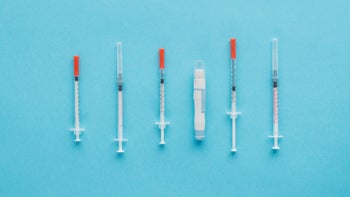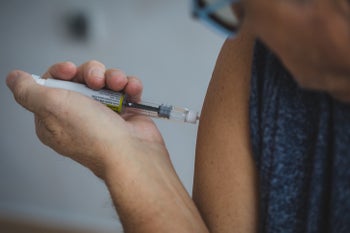
What’s the Difference Between Rapid-Acting and Long-Acting Insulins?
Key takeaways:
Long-acting insulins and rapid-acting insulins are commonly used to treat diabetes.
The main differences between long-acting insulin and rapid-acting insulin are how fast and how long they work.
Rapid-acting insulin works quickly and for a few hours to help prevent high blood sugar after meals. Long-acting insulin takes longer to start working but provides a baseline level of insulin for most of the day.

Insulin is an important treatment for people with diabetes. Some insulins are long-acting, some are rapid-acting, and some are in between.
For people with Type 1 diabetes, insulin is essential. This is because their bodies do not make insulin, which leads to high blood sugar. Injecting insulin brings their blood sugar down to safe levels. People with Type 1 diabetes usually use a combination of long-acting and rapid-acting insulin.
For people with Type 2 diabetes, insulin is not always needed. But it can still be an effective (and sometimes necessary) treatment. Their bodies may not make enough insulin, and they may not respond normally to insulin (also called insulin resistance). People with Type 2 diabetes usually start with long-acting insulin (if they need insulin). Rapid-acting insulin may be added later on.
So what’s the difference between long-acting and rapid-acting insulin? In this article, we’ll cover the main differences and a few other things you should know.
What is long-acting insulin?
Long-acting or basal insulin gives you a slow, steady release of insulin. The insulin works throughout the day to control your blood sugar between meals, and overnight. Long-acting insulin can be injected once or twice daily, depending on the specific type of insulin. It is often used as a treatment for both Type 1 and Type 2 diabetes.
Long-acting insulin names
You’re probably familiar with most insulins by brand name. Sometimes, there are two or more brand names for a specific insulin, based on differences in formulation. Common names of long-acting insulins include:
Read more like this
Explore these related articles, suggested for readers like you.
How much time does long-acting insulin take to work?
Long-acting insulin takes about 2 hours to start lowering blood sugar. This type of insulin is designed to last a long time, so it takes longer than other insulins to start working. Long-acting insulin usually does not “peak,” meaning that it maintains a steady insulin level throughout the day.
How long does long-acting insulin last?
The duration of action (how long the medication keeps working) varies between long-acting products. But long-acting insulin should last up to 24 hours. The following are the typical duration of action times for each long-acting insulin:
Insulin glargine: 24 hours
Insulin detemir: 12 to 24 hours
Should I take long-acting insulin at bedtime?
It depends. There’s no consensus on what time of day is best to inject long-acting insulin, and it may be different from person to person. Injecting your insulin at the same time each day (for once-daily dosing) is more important than the exact time of day when you inject it.
Some experts say that injecting insulin glargine at lunch time or dinner time, instead of bedtime, may lower the risk of high blood sugar in people with Type 1 diabetes. You should check with your healthcare provider to determine the best time of day for you to take long-acting insulin.
Do any insulin products last longer than long-acting insulins?
Yes. There are two ultra-long-acting insulin products: insulin glargine U300 (Toujeo) and insulin degludec (Tresiba). These insulins begin working within 6 hours of injection and last for 36 to 42 hours.
What is rapid-acting insulin?
Rapid-acting or meal-time insulin is usually taken before, during, or after a meal to lower your blood sugar levels associated with meals.
Examples of rapid-acting insulins are:
How long does it take rapid-acting insulin to begin working?
The onset of action (when the insulin starts to kick in) varies between rapid-acting insulin products. But they usually start working within 15 minutes depending on the insulin. Rapid-acting insulins last about 2 to 4 hours.
Do I need more than one insulin?
Maybe. It’s up to your healthcare provider to determine the best medication regimen for you.
Some people with Type 2 diabetes may only need to use a long-acting insulin to get their blood sugar control on track. Others may need a combination of rapid-acting and long-acting insulins to best control their blood sugar.
If you are using an insulin pump, you will only need to use a rapid or short-acting insulin. Typically, only patients with Type 1 diabetes use an insulin pump. The pump gives you a slow and steady amount of insulin to cover you all day like a long-acting insulin would do. However, it’s a good idea to have a back-up of long-acting insulin on hand in case your pump should fail.
Is there anything in between rapid-acting and long-acting?
Yes. There are short-acting and intermediate-acting insulins available. Regular insulin (Novolin R, Humulin R) is an example of short-acting insulin. Neutral protamine hagedorn (NPH) insulin (Novolin N, Humulin N) is an example of intermediate-acting insulin.
Short-acting insulins are used like rapid-acting insulin to cover blood sugar elevation after eating. Intermediate-acting insulins are similar to long-acting insulins: They cover blood sugar elevations when the rapid-acting or short-acting insulins finish working. But their duration of action is shorter than long-acting insulins.
What are combination insulins?
Some insulin products combine fast-acting and intermediate-acting insulins. The two insulins work together to help manage blood sugar between meals and at night. They also cover blood sugar “spikes” that happen when you eat. Here are a few examples of combination insulins:
Insulin lispro protamine and insulin lispro (Humalog 50/50, Humalog 75/25)
Insulin aspart protamine and insulin aspart (Novolog 70/30 Mix)
NPH insulin and regular insulin (Humulin 70/30, Novolin 70/30)
Combination insulin products typically only need to be injected twice daily, since they are single insulin products that contain both a shorter-acting and intermediate-acting insulin.
The bottom line
Long-acting insulin is a slow-release insulin that works throughout the day to maintain a baseline insulin level. Rapid-acting insulin is used to cover meals and prevent a sharp rise in blood sugar after eating.
People with Type 1 diabetes often use long-acting insulin and rapid-acting insulin to help control blood sugar. People with Type 2 diabetes sometimes use these insulins for blood sugar control.
Other types of insulin include intermediate-acting insulin, short-acting insulin, and ultra-long-acting insulin.
Your healthcare provider will work with you to determine the best insulin regimen for you.
Why trust our experts?


References
American Diabetes Association. (n.d.). Understanding insulin resistance.
American Diabetes Association Professional Practice Committee. (2022). 9. Pharmacologic approaches to glycemic treatment: Standards of Medical Care in Diabetes—2022. Diabetes Care.
Ashwell, S.G., et al. (2006). Optimal timing of injection of once-daily insulin glargine in people with Type 1 diabetes using insulin lispro at meal-times. Diabetic Medicine.
Centers for Disease Control and Prevention. (2021). Types of insulin.
Porcellati, F., et al. (2015). Pharmacokinetics and pharmacodynamics of insulin glargine given in the evening as compared with in the morning in type 2 diabetes. Diabetes Care.
University of California, San Francisco. (n.d.). Types of insulin.




























